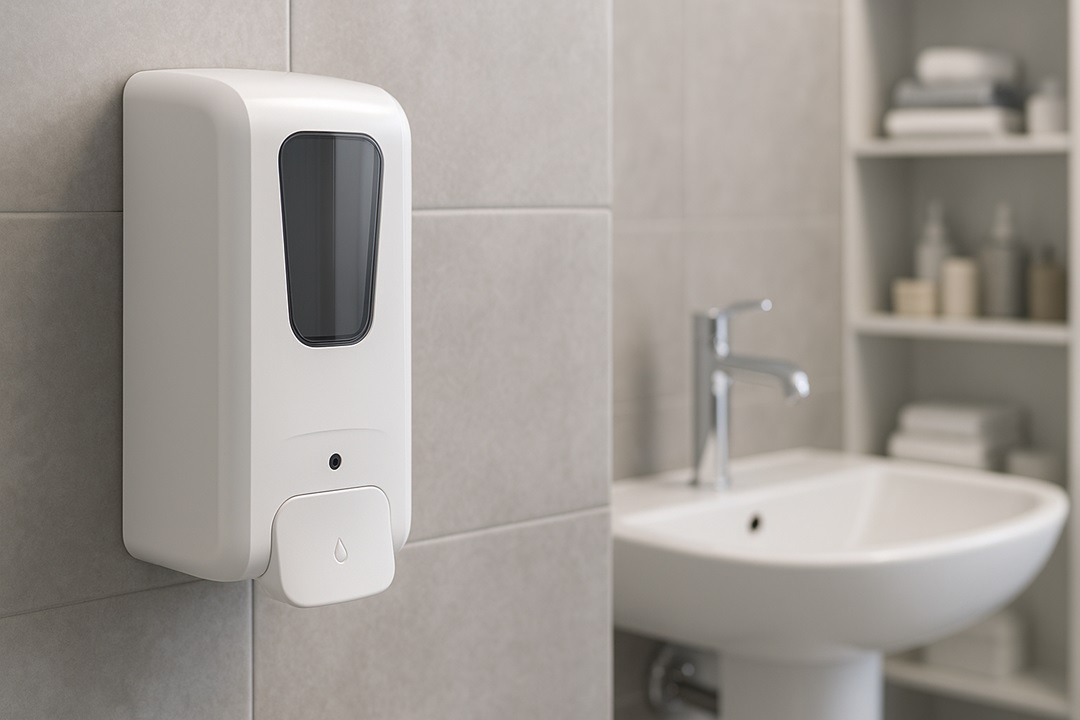Choosing a Touchless Soap Dispenser for Healthcare Settings
Introduction
In healthcare environments, effective hand hygiene is one of the most effective precautions against the spread of infections. The Centers for Disease Control and Prevention (CDC) offer that correct hand hygiene protocols reduce the risk of healthcare-associated infections (HAIs), which develop in 1 of every 31 patients on a particular day in hospitals.
Touchless soap dispensers are critical to compliance and infection prevention in that they minimize contact surfaces, improving safety and workflow productivity within clinics, hospitals, and laboratories.
👉 Explore our line of commercial touchless soap dispensers for hospitals, clinics, and labs.
Why Touchless Soap Dispensers Matter to Healthcare
Infection Control
The American Journal of Infection Control found that touchless dispensers significantly reduce the risk of cross-contamination compared to manual soap pumps. When healthcare providers do not have to touch a dispenser with dirty hands, the risk of transmission of pathogenic germs between users decreases significantly.
Compliance
The World Health Organization (WHO) highlights that making hand washing convenient and intuitive promotes relentless adherence. Touchless technology guarantees soap to be accessible where it is needed — no levers, buttons, or mechanical opposition needed.
Operational Efficiency
Cutting soap usage up to 30% annually, says a report on Infection Control Today, automatic dispensers with controlled soap output pay hospitals back. Controlled output minimizes waste and abuse while delivering the appropriate amount for effective handwashing.
Modern Standards
Touchless technology complies with new Joint Commission and CDC infection prevention standards. Settings that include sensor-based dispensers demonstrate adherence to modern hygiene standards and best practices for operations.
Points to Consider
1. Dispenser Capacity
Large dispensers (1000–1500 mL) are ideal for very busy hospital wards or operating rooms, where hand frequency is high.
Small units are suitable for patient rooms and office spaces.
👉 View our hospital-grade soap dispensers.
2. Sensor Technology
Infrared sensors are the most common and reliable, giving accurate detection with no contact. Proximity sensors with sophisticated features can also prevent false triggering in high-traffic areas.
National Center for Biotechnology Information (NCBI) studies show that precision of the sensors directly contributes to compliance, as inconsistent devices discourage repeated use.
3. Soap Disperser Compatibility
Healthcare soap dispensers must support antimicrobial soaps, such as chlorhexidine-based products, which are essential for surgical hand antisepsis. Foam, liquid, or gel soap-handling units create flexibility among various clinical departments.
👉 Investigate foaming dispensers for healthcare.
4. Power Source
Battery-powered: These dispensers are convenient and easy to install but still, it’s necessary to keep an eye on them and to replace their batteries.
AC-powered: These dispensers are more applicable to the high-usage places where the uninterrupted service is a must.
Hybrid models: These dispensers are more reliable — the dispenser will stay operational when there is nothing left in the battery or in the case of power outages.
5. Durability & Materials
The choice of material affects the look and hygiene of the dispenser:
- ABS plastic: It is chemical-resistant and lightweight, therefore, it’s mainly used in clinics.
- Stainless steel: It is sturdy and resistant to vandals, hence, it is used most in public places or places with high foot traffic.
👉 What about stainless steel dispensers?
6. Ease of Maintenance
The easy-to-see refill windows cut down on inspection time while the lockable lids protect against unwanted attention — this is a must in public restrooms and waiting areas.
Among the various options are:
- Cartridge-based for refilling systems that are sanitary.
- Systems with bulk filling that are both cost and sustainability-minded.
7. Compliance & Certifications
In the choice of dispensers, make sure they are in accordance with:
- ADA Accessibility Standards thus, users can have easy access to them.
- CDC Hand Hygiene Guidelines.
- WHO SAVE LIVES: Clean Your Hands Campaign.
The certificate assures that the dispenser is contributing to the goal of health and regulation cleanliness.
According to a report by a PubMed study, hospitals that made the switch to automatic dispensers had up to 23% fewer HAIs, which translated into lower cost of patient care and improved outcomes.
Most Popular Use Cases
| Location | Favored Features |
|---|---|
| Hospital Wards | Stainless steel, high-volume wall-mounted models |
| Patient Rooms | Quiet, space-saving models with refill windows |
| Surgical Theaters | Antimicrobial soap-compatible, foam dispensing systems |
| Waiting Areas | Tamper-evident, attractive designs |
👉 Examine hospitals’ bulk buying options.
Conclusion
Touchless soap dispensers are no longer a nicety in healthcare — they are a necessary component of infection prevention, patient safety, and staff compliance. By investing in forward-looking sensor-activated, long-life, and regulation-compliant dispensers, facilities can upgrade hygiene protocols and accrue quantifiable cost savings in the long run.
Such strategic system not only advocated safety but also reflected a sense of forward-looking attitude towards the healthcare standards and patient welfare.
👉 See our full line of touchless dispensers for healthcare facilities.

No responses yet